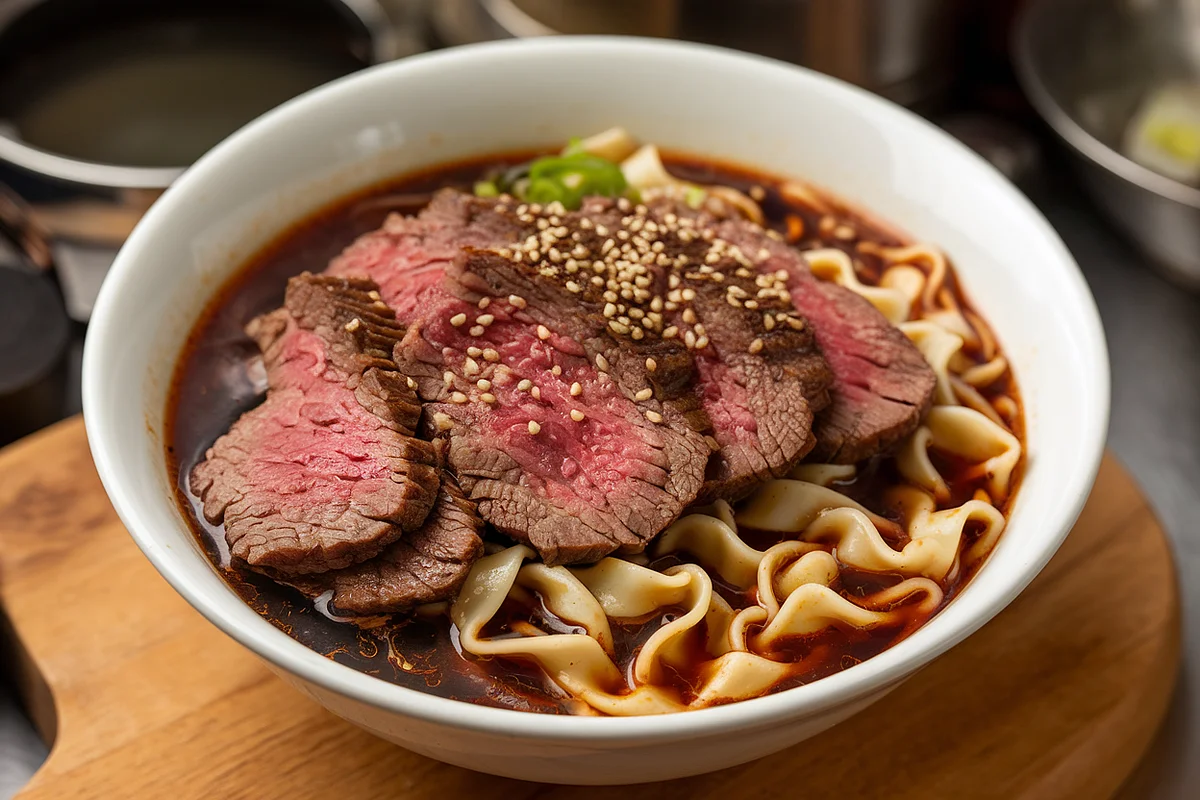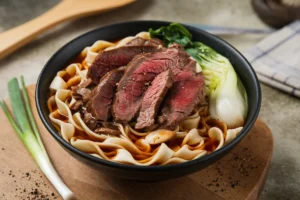When it comes to comforting, hearty dinners that warm you from the inside out, nothing beats the classic combination of beef and noodles. This dish offers a blend of rich flavors, tender meat, and savory broth, making it a go-to for many households. Whether you’re looking for a cozy weeknight meal or a hearty weekend indulgence, beef and noodles is a versatile recipe that can be tailored to suit your taste buds.
In this detailed guide, we will dive deep into everything you need to know to make the best beef and noodles recipe. From choosing the right cut of beef to perfecting the texture of your noodles, you’ll find all the tips and tricks you need to recreate this comfort food classic. Plus, we’ll explore variations that cater to different diets and cooking methods.
History of Beef and Noodles
Beef and noodles is a dish with roots in various culinary traditions around the world. From Eastern European beef stroganoff to Asian-inspired beef noodle soups, the combination of tender meat and satisfying noodles is one that transcends cultures. The American version, however, tends to be more focused on slow-cooked beef that melts in your mouth, paired with thick, chewy noodles.
Historically, beef and noodles became popular due to their affordability and ability to stretch a meal. By using inexpensive cuts of meat like chuck roast, you could create a filling dish that serves a large family. Today, it’s enjoyed as a comfort food staple, perfect for cold weather or when you need a hearty dish to serve a crowd.
For a deep dive into choosing the perfect cut of beef, you can explore the Beef Chuck Roast Recipe to ensure you’re selecting the best option for tenderness and flavor. This guide offers insights into the best ways to prepare beef chuck, one of the most commonly used cuts in this recipe.
The Evolution of Beef and Noodles
As with many classic recipes, beef and noodles have evolved over time to accommodate different preferences and available ingredients. What was once a simple dish made with basic ingredients like flour, water, and beef broth has now become an adaptable meal with endless variations.
Some variations of beef and noodles incorporate different noodle types, such as egg noodles or gluten-free options. If you’re curious about what noodles might work best, check out this comprehensive guide to Noodle Varieties, which breaks down the differences between frozen, dried, and fresh noodles.
Ingredients Breakdown
To create the best beef and noodles recipe, selecting the right ingredients is crucial. Here’s a breakdown of everything you’ll need, as well as some substitutions and variations for each component.
Essential Ingredients
- Beef: Chuck roast, stew meat, or any affordable cut of beef that becomes tender with slow cooking. The meat is often seared to lock in the flavors before being slow-cooked in broth.
- Noodles: Thick-cut egg noodles like the Reames brand or any other fresh, chewy noodle that can hold up to slow cooking.
- Beef broth: A rich and flavorful broth forms the base of this dish, contributing to its deep, savory flavor. You can also use homemade broth for an extra layer of flavor.
- Onions and Garlic: These aromatics form the base of the dish and add depth to the overall flavor.
- Worcestershire Sauce: This adds umami and enhances the richness of the dish.
- Mushrooms: Optional but recommended for an earthy flavor that pairs beautifully with the beef.
- Seasonings: A blend of salt, pepper, and fresh thyme (or dried if fresh is unavailable).
Optional Add-ins
- Carrots, peas, or other vegetables to add texture and nutritional value.
- Sour cream or cream cheese for a creamy twist, especially in stroganoff-inspired variations.
- A splash of red wine or cooking sherry to elevate the flavor of the broth.
How to Prepare the Best Beef and Noodles
Now that you have your ingredients ready, it’s time to cook. Follow these steps carefully to ensure that your beef turns out tender and your noodles are perfectly cooked.
Step-by-Step Recipe Guide
1. Prepare the Beef
- Start by cutting your beef into 1-inch cubes if not already done.
- Coat the beef with a mixture of flour, salt, and pepper. The flour helps create a thick, flavorful broth later in the cooking process.
2. Sear the Beef
- Heat a large Dutch oven or skillet over medium-high heat.
- Add a tablespoon of olive oil and butter to the pan, swirling to coat.
- Sear the beef cubes on all sides until golden brown. This step is crucial for building a rich, deep flavor in your dish.
3. Sauté the Aromatics
- Once the beef is seared, remove it from the pan and set it aside.
- In the same pot, add chopped onions, garlic, and mushrooms. Sauté them for about 5-7 minutes until soft and golden.
4. Simmer the Broth
- Return the beef to the pot along with the sautéed aromatics.
- Add the beef broth, Worcestershire sauce, and fresh thyme.
- Bring the mixture to a simmer, then reduce the heat to low and cover. Let it cook for about 1.5 to 2 hours, or until the beef is tender and falling apart.
5. Cook the Noodles
- Add the egg noodles directly into the pot with the beef and broth. This allows the noodles to absorb the rich flavors as they cook.
- Cook for an additional 20-25 minutes, stirring occasionally until the noodles are tender and the broth has thickened.
6. Serve and Garnish
- Serve the beef and noodles hot, garnished with fresh parsley or a dollop of sour cream if desired.
Key Techniques for Perfect Beef and Noodles
To ensure your beef and noodles turn out perfectly every time, there are a few key techniques you should follow:
- Searing the Beef: This step locks in the flavor and creates a caramelized crust that adds depth to the dish.
- Slow Cooking for Tenderness: Use a low simmer to break down tough cuts of meat like chuck roast, making the beef incredibly tender.
- Cooking Noodles in the Broth: By cooking the noodles in the broth, the starch from the noodles helps thicken the dish, giving it a more cohesive texture.
Variations and Modifications
One of the best things about beef and noodles is its versatility. Here are some popular variations and modifications to suit different dietary preferences or simply to change things up.
Gluten-Free Version
- Swap the regular noodles for gluten-free noodles. Rice noodles or gluten-free egg noodles work well.
- Ensure that the broth and Worcestershire sauce you use are certified gluten-free.
Low-Carb Beef and Noodles
- Replace the noodles with spiralized zucchini (zoodles) or spaghetti squash for a lower-carb option.
- Cook the beef and broth as usual, and simply add the vegetable noodles towards the end of cooking.
Stroganoff-Style Beef and Noodles
- Add a generous spoonful of sour cream or cream cheese to the finished dish for a creamy, tangy twist.
- You can also include a dash of paprika and mustard to give it a more traditional beef stroganoff flavor.
Asian-Inspired Beef Noodles
- Swap the beef broth for soy sauce-based broth, and add ingredients like ginger, sesame oil, and green onions for an Asian twist.
- Consider using ramen or udon noodles to complete the dish.
FAQs About Beef and Noodles
Here are some common questions people ask about making the best beef and noodles recipe:
What kind of beef is best for beef and noodles?
The most common cuts of beef used are chuck roast, bottom round, or stew meat. These cuts have the connective tissue that breaks down during slow cooking, making the meat tender and flavorful.
Can I make beef and noodles in a slow cooker?
Yes! After searing the beef and sautéing the aromatics, transfer everything to a slow cooker. Cook on low for 6-8 hours or high for 4-6 hours, then add the noodles towards the last 20-30 minutes of cooking.
How can I make beef and noodles more flavorful?
- Use high-quality beef broth and season generously with salt, pepper, and herbs like thyme.
- Adding a splash of red wine or Worcestershire sauce also deepens the flavor.
- Cooking the noodles directly in the broth will help absorb those rich flavors.
What noodles should I use for beef and noodles?
Thick-cut egg noodles are the traditional choice for this recipe, but you can also use other types like ramen or gluten-free noodles depending on your dietary needs.
Serving and Storage
What to Serve with Beef and Noodles
Beef and noodles is a complete meal on its own, but you can pair it with side dishes to complement the flavors. Here are a few ideas:
- Mashed potatoes or crusty bread to soak up the broth.
- A simple green salad or roasted vegetables to balance the richness.
- A glass of red wine or a robust beer like stout for pairing.
Storing and Reheating Beef and Noodles
If you have leftovers, store them in an airtight container in the fridge for up to 3 days. Reheat the dish gently on the stovetop, adding a little beef broth if needed to loosen the sauce.
You can also freeze beef and noodles, but it’s best to freeze the beef and broth separately from the noodles to maintain their texture. When ready to serve, thaw the beef and broth, reheat, and add freshly cooked noodles.
Conclusion
There’s nothing quite like a bowl of hearty beef and noodles to make you feel warm and satisfied. This dish is versatile, allowing for various modifications depending on your dietary preferences or ingredient availability. With the right ingredients, slow cooking techniques, and a few special add-ins, you can create the best beef and noodles recipe that’s perfect for family dinners, gatherings, or even meal prep.
Experiment with the recipe and try some of the variations we’ve discussed to make it your own. Whether you’re sticking with the classic version or venturing into Asian-inspired or low-carb twists, beef and noodles will always deliver that comforting, savory satisfaction.



